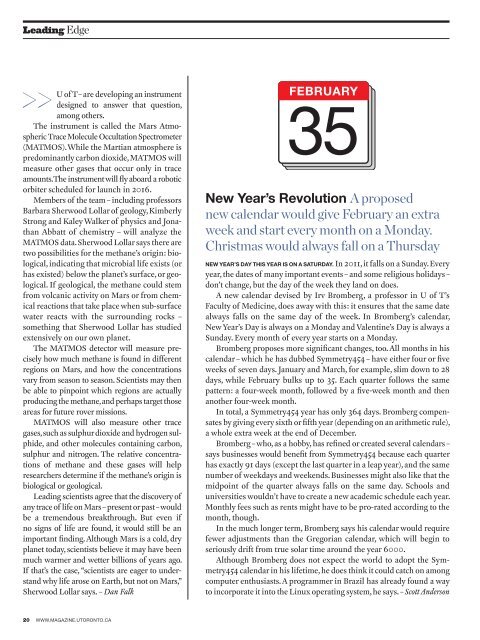The Next Big Idea 10 concepts that could - University of Toronto ...
The Next Big Idea 10 concepts that could - University of Toronto ...
The Next Big Idea 10 concepts that could - University of Toronto ...
Create successful ePaper yourself
Turn your PDF publications into a flip-book with our unique Google optimized e-Paper software.
Leading Edge<br />
U <strong>of</strong> T – are developing an instrument<br />
designed to answer <strong>that</strong> question,<br />
among others.<br />
<strong>The</strong> instrument is called the Mars Atmospheric<br />
Trace Molecule Occultation Spectrometer<br />
(MATMOS). While the Martian atmosphere is<br />
predominantly carbon dioxide, MATMOS will<br />
measure other gases <strong>that</strong> occur only in trace<br />
amounts. <strong>The</strong> instrument will fly aboard a robotic<br />
orbiter scheduled for launch in 2016.<br />
Members <strong>of</strong> the team – including pr<strong>of</strong>essors<br />
Barbara Sherwood Lollar <strong>of</strong> geology, Kimberly<br />
Strong and Kaley Walker <strong>of</strong> physics and Jonathan<br />
Abbatt <strong>of</strong> chemistry – will analyze the<br />
MATMOS data. Sherwood Lollar says there are<br />
two possibilities for the methane’s origin: biological,<br />
indicating <strong>that</strong> microbial life exists (or<br />
has existed) below the planet’s surface, or geological.<br />
If geological, the methane <strong>could</strong> stem<br />
from volcanic activity on Mars or from chemical<br />
reactions <strong>that</strong> take place when sub-surface<br />
water reacts with the surrounding rocks –<br />
something <strong>that</strong> Sherwood Lollar has studied<br />
extensively on our own planet.<br />
<strong>The</strong> MATMOS detector will measure precisely<br />
how much methane is found in different<br />
regions on Mars, and how the concentrations<br />
vary from season to season. Scientists may then<br />
be able to pinpoint which regions are actually<br />
producing the methane, and perhaps target those<br />
areas for future rover missions.<br />
MATMOS will also measure other trace<br />
gases, such as sulphur dioxide and hydrogen sulphide,<br />
and other molecules containing carbon,<br />
sulphur and nitrogen. <strong>The</strong> relative concentrations<br />
<strong>of</strong> methane and these gases will help<br />
researchers determine if the methane’s origin is<br />
biological or geological.<br />
Leading scientists agree <strong>that</strong> the discovery <strong>of</strong><br />
any trace <strong>of</strong> life on Mars – present or past – would<br />
be a tremendous breakthrough. But even if<br />
no signs <strong>of</strong> life are found, it would still be an<br />
important finding. Although Mars is a cold, dry<br />
planet today, scientists believe it may have been<br />
much warmer and wetter billions <strong>of</strong> years ago.<br />
If <strong>that</strong>’s the case, “scientists are eager to understand<br />
why life arose on Earth, but not on Mars,”<br />
Sherwood Lollar says. – Dan Falk<br />
New Year’s Revolution A proposed<br />
new calendar would give February an extra<br />
week and start every month on a Monday.<br />
Christmas would always fall on a Thursday<br />
new year’s day this year is on a Saturday. In 2011, it falls on a Sunday. Every<br />
year, the dates <strong>of</strong> many important events – and some religious holidays –<br />
don’t change, but the day <strong>of</strong> the week they land on does.<br />
A new calendar devised by Irv Bromberg, a pr<strong>of</strong>essor in U <strong>of</strong> T’s<br />
Faculty <strong>of</strong> Medicine, does away with this: it ensures <strong>that</strong> the same date<br />
always falls on the same day <strong>of</strong> the week. In Bromberg’s calendar,<br />
New Year’s Day is always on a Monday and Valentine’s Day is always a<br />
Sunday. Every month <strong>of</strong> every year starts on a Monday.<br />
Bromberg proposes more significant changes, too. All months in his<br />
calendar – which he has dubbed Symmetry454 – have either four or five<br />
weeks <strong>of</strong> seven days. January and March, for example, slim down to 28<br />
days, while February bulks up to 35. Each quarter follows the same<br />
pattern: a four-week month, followed by a five-week month and then<br />
another four-week month.<br />
In total, a Symmetry454 year has only 364 days. Bromberg compensates<br />
by giving every sixth or fifth year (depending on an arithmetic rule),<br />
a whole extra week at the end <strong>of</strong> December.<br />
Bromberg – who, as a hobby, has refined or created several calendars –<br />
says businesses would benefit from Symmetry454 because each quarter<br />
has exactly 91 days (except the last quarter in a leap year), and the same<br />
number <strong>of</strong> weekdays and weekends. Businesses might also like <strong>that</strong> the<br />
midpoint <strong>of</strong> the quarter always falls on the same day. Schools and<br />
universities wouldn’t have to create a new academic schedule each year.<br />
Monthly fees such as rents might have to be pro-rated according to the<br />
month, though.<br />
In the much longer term, Bromberg says his calendar would require<br />
fewer adjustments than the Gregorian calendar, which will begin to<br />
seriously drift from true solar time around the year 6000.<br />
Although Bromberg does not expect the world to adopt the Symmetry454<br />
calendar in his lifetime, he does think it <strong>could</strong> catch on among<br />
computer enthusiasts. A programmer in Brazil has already found a way<br />
to incorporate it into the Linux operating system, he says. – Scott Anderson<br />
20 WWW.MAGAZINE.UTORONTO.CA
















